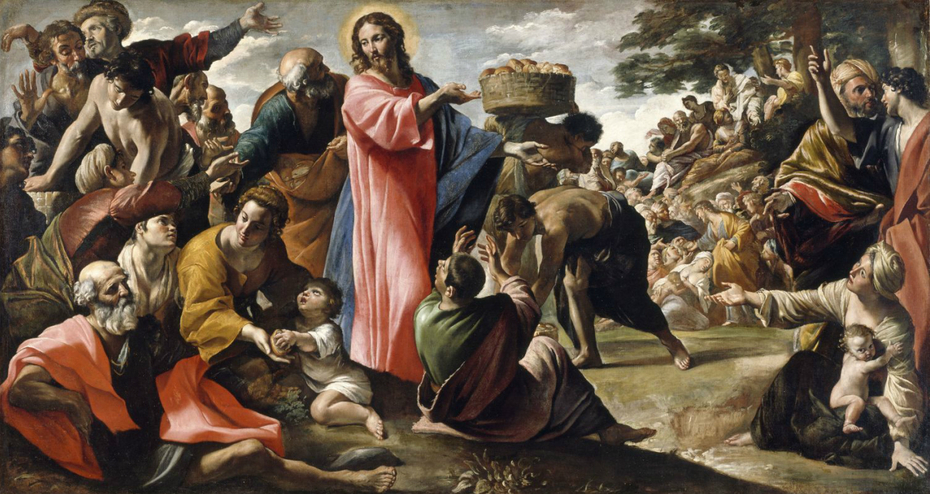Home l Liturgy & Sacraments l Liturgical Calendar
Laetare Sunday – The Fourth Sunday of Lent – Sunday, March 10, 2024

This Sunday, called, from the first word of the Introit, Laetare Sunday, is one of the most solemn of the year. The Church interrupts her Lenten mournfulness; the chants of the Mass speak of nothing but joy and consolation; the Organ, which has been silent during the preceding three Sundays, now gives forth its melodious voice; the Deacon resumes his Dalmatic, and the Subdeacon his Tunic; and instead of purple, Rose-colored Vestments are allowed to be used. These same rites were practiced in Advent, on the third Sunday, called Gaudete. The Church’s motive for introducing this expression of joy in to-day’s Liturgy, is to encourage her Children to persevere fervently to the end of this holy Season. The real Mid-Lent was last Thursday, as we have already observed; but the Church, fearing lest the joy might lead to some infringement on the spirit of penance, has deferred her own notice of it to this Sunday, when she not only permits, but even bids, her children to rejoice!
The Station at Rome, is in the Basilica of Holy Cross in Jerusalem, one of the seven principal Churches of the Holy City. It was built in the fourth century, by the Emperor Constantine, in one of his villas, called Sessorius, on which account it goes also under the name of the Sessorian Basilica. The Emperor’s mother, St. Helen, enriched it with most precious relies, and wished to make it the Jerusalem of Rome. It was with this intention that she ordered a great quantity of earth, taken from Mount Calvary, to be put on the site. Among the other Relics of the Instruments of the Passion which she gave to this Church, was the Inscription which was fastened to the Cross; it is still kept there and is called the Title of the Cross. The name of Jerusalem, – which has been given to this Basilica, and which recalls to our minds the heavenly Jerusalem, towards which we are tending, – suggested the choosing it as today’s Station. Up to the fourteenth century, (when Avignon became, for a time, the City of the Popes,) the ceremony of the Golden Rose took place in this Church; at present, it is blessed in the Palace where the Sovereign Pontiff happens to be residing at this Season.
The blessing of the Golden Rose is one of the ceremonies peculiar to the Fourth Sunday of Lent, which is called on this account Rose Sunday. The thoughts suggested by this flower harmonize with the sentiments wherewith the Church would now inspire her Children. The joyous time of Easter is soon to give them a spiritual Spring, of which that of nature is but a feeble image. Hence, we cannot be surprised that the institution of this ceremony is of a very ancient date. We find it observed under the Pontificate of St. Leo the Ninth (eleventh century); and we have a Sermon on the Golden Rose preached by the glorious Pope Innocent the Third, on this Sunday, and in the Basilica of Holy Cross in Jerusalem. In the Middle Ages, when the Pope resided in the Lateran Palace, having first blessed the Rose, he went on horseback to the Church of the Station. He wore the mitre, was accompanied by all the Cardinals, and held the blessed Flower in his hand. Having reached the Basilica, he made a discourse on the mysteries symbolized by the beauty, the color, and the fragrance of the Rose. Mass was then celebrated. After the Mass, the Pope returned to the Lateran Palace. Surrounded by the sacred College, he rode across the immense plain which separates the two Basilicas, with the mystic Flower still in his hand. We may imagine the joy of the people as they gazed upon the holy symbol. When the procession had got to the Palace gates, if there were a Prince present, it was his privilege to hold the stirrup, and assist the Pontiff to dismount; for which filial courtesy he received the Rose, which had received so much honor and caused such joy.
At present, the ceremony is not quite so solemn; still the principal rites are observed. The Pope blesses the Golden Rose in the Vestiary; he anoints it with Holy Chrism, over which he sprinkles a scented powder, as formerly; and when the hour for Mass is come, he goes to the Palace Chapel, holding the Flower in his hand. During the Holy Sacrifice, it is fastened to a golden rose-branch prepared for it on the Altar. After the Mass, it is brought to the Pontiff, who holds it in his hand as he returns from the Chapel to the Vestiary. It is usual for the Pope to send the Rose to some Prince or Princess, as a mark of honor; sometimes, it is a City or a Church that receives the Flower.
We subjoin a free translation of the beautiful Prayer used by the Sovereign Pontiff when blessing the Golden Rose. It will give our readers a clearer appreciation of this ceremony, which adds so much solemnity to the Fourth Sunday of Lent. “O God! by whose word and power all things were created, and by whose will they are all governed! O thou, that art the joy and gladness of all thy Faithful people! we beseech thy Divine Majesty, that thou vouchsafe to bless and sanctify this Rose, so lovely in its beauty and fragrance. We are to bear it, this day, in our hands, as a symbol of spiritual joy; that thus, the people that is devoted to thy service, being set free from the captivity of Babylon, by the grace of thine Only Begotten Son, who is the glory and the joy of Israel, may show forth, with a sin cere heart, the joys of that Jerusalem, which is above, and is our Mother. And whereas thy Church seeing this symbol, exults with joy, for the glory of thy Name; – do thou, O Lord! give her true and perfect happiness. Accept her devotion, forgive us our sins, increase our faith; heal us by thy word, protect us by thy mercy; remove all obstacles; grant us all blessings; that thus, this same thy Church may offer unto thee the fruit of good works; and walking in the odor of the fragrance of that Flower, which sprang from the Root of Jesse, and is called the Flower of the Field, and the Lily of the Valley, may she deserve to enjoy an endless joy in the bosom of heavenly glory, in the society of all the Saints, together with that Divine Flower, who liveth and reigneth with thee in the unity of the Holy Ghost, world without end. Amen.”
We now come to the explanation of another name given to the Fourth Sunday of Lent, which was suggested by the Gospel of the day. We find this Sunday called in several ancient documents, the Sunday of the Five Loaves. The miracle alluded to in this title not only forms an essential portion of the Church’s instructions during Lent, but it is also an additional element of to-day’s joy. We forget for an instant the coming Passion of the Son of God, to give our attention to the greatest of the benefits he has bestowed on us; for under the figure of these Loaves multiplied by the power of Jesus, our Faith sees that Bread which came down from heaven, and given life to the world’ [St. John, 6: 33]. The Pasch, says our Evangelist, was near at hand; and, in a few days, our Lord will say to us: With desire I have desired to eat this Pasch with you [St. Luke, xxii. 15]. Before leaving this world to go to his Father, Jesus desires to feed the multitude that follows him; and in order to this, he displays his omnipotence. Well may we admire that creative power, which feeds five thousand men with five loaves and two fishes, and in such wise, that even after all have partaken of the feast as much as they would, there remain fragments enough to fill twelve baskets. Such a miracle is, indeed, an evident proof of Jesus’ mission; but he intends it as a preparation for something far more wonderful; he intends it as a figure and a pledge of what he is soon to do, not merely once or twice, but every day, even to the end of time; not only for five thousand men, but for the countless multitudes of believers. Think of the millions, who, this very year, are to partake of the banquet of the Pasch; and yet, He whom we have seen born in Bethlehem, (the House of Bread,) He is to be the nourishment of all these guests; neither will the Divine Bread fail. We are to feast as did our fathers before us; and the generations that are to follow us, shall be invited as we now are, to come and taste how sweet is the Lord [Psalm 23: 9].
But observe, it is in a desert place, (as we learn from St. Matthew, [St. Matthew, 14: 13]) that Jesus feeds these men, who represent us, Christians. They have quitted the bustle and noise of cities in order to follow him. So anxious are they to hear his words, that they fear neither hunger nor fatigue; and their courage is rewarded. A like recompense will crown our labors, – our fasting and abstinence, – which are now more than half over. Let us, then, rejoice, and spend this day with the light-heartedness of pilgrims, who are near the end of their journey. The happy moment is advancing, when our soul, united and filled with her God, will look back with pleasure on the fatigues of the body, which, together with our heart’s compunction, have merited for her a place at the Divine Banquet.
The primitive Church proposed this miracle of the multiplication of the loaves as a symbol of the Eucharist, the Bread that never fails. We find it frequently represented in the paintings of the Catacombs and on the bas-reliefs of the ancient Christian tombs. The Fishes, too, that were given together with the Loaves, are represented on these venerable monuments of our faith; for the early Christians considered the Fish to be the symbol of Christ, because the word Fish in Greek, is made up of five letters, each of which is the initial of these words: Jesus Christ, Son (of) God, Savior.
The Greek Church, too, keeps this Sunday with much solemnity. According to her manner of counting the days of Lent, this is the great day of the week called, as we have already noticed, Mesonestios. The solemn adoration of the Cross takes place to-day; and breaking through her rule of never admitting a Saint’s Feast during Lent, this mid-Lent Sunday is kept in honor of the celebrated Abbot of the Monastery of Mount Sinai, St. John Climacus, who lived in the 6th century.
Dom Prosper Gueranger
Copyright © 2015-2025 Saint Joseph Catholic Church, Latin Mass Parish, 602 S 34th St., Tacoma, WA 98418. All Rights Reserved.
Website comments or questions: info@saintjosephtacoma.org


